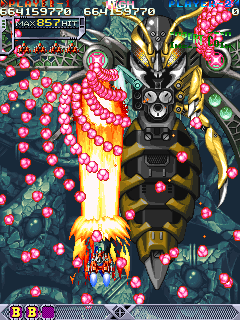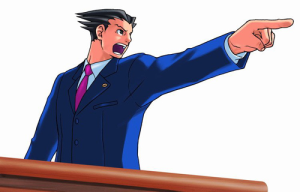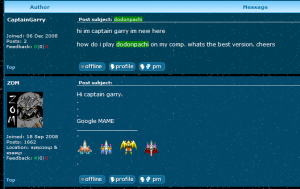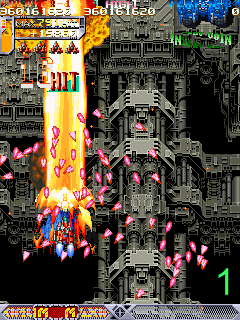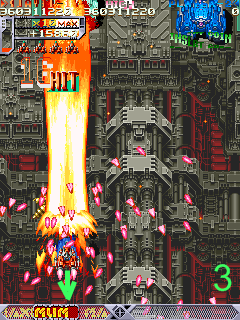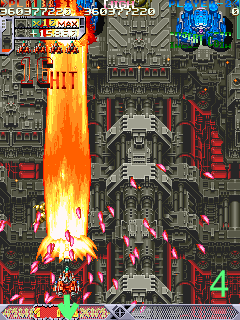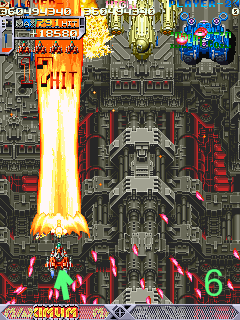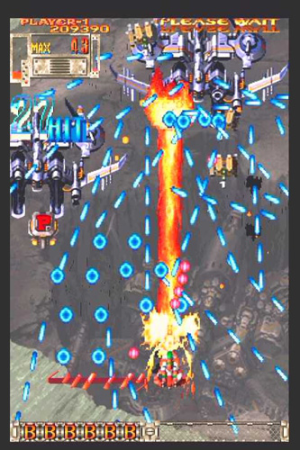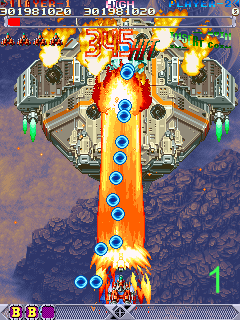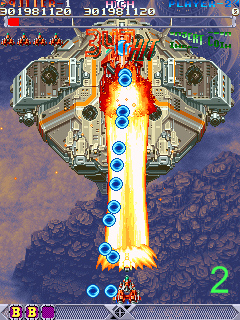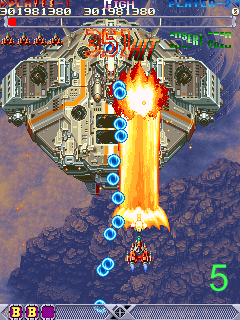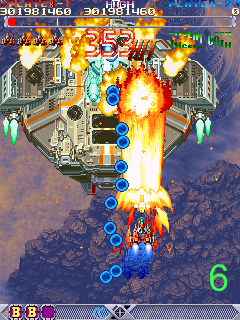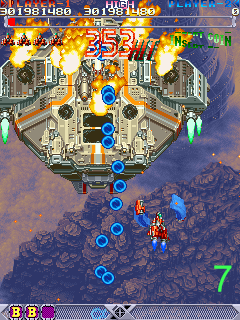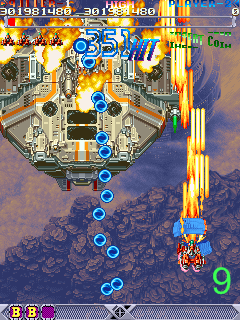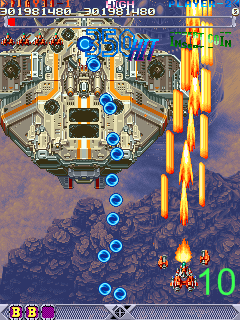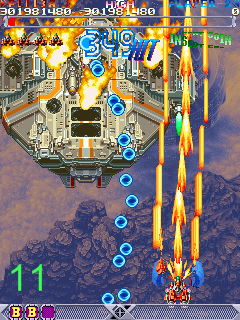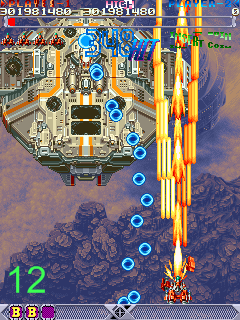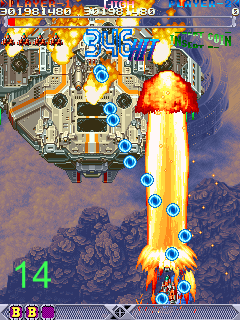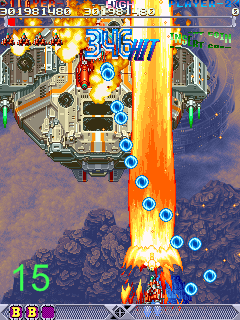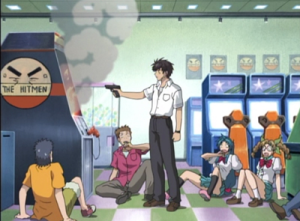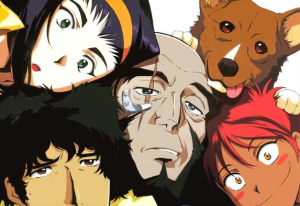Full Extent of the Jam
This space is for the as-titled guide by PROMETHEUS, originally posted in this thread over at System11. This is a very comprehensive and at least historically well-regarded guide to approaching and improving at shmups with a focus on danmaku shmups. The guide was written with DoDonPachi as the primary point of reference, but the information is largely applicable across the genre. Formatting for the wiki has begun for posterity and preservation. Care will be taken in making sure the majority of the original formatting is preserved and the text will otherwise by directly copied and pasted.
A few notes before reading this guide in any of its forms:
- It is over 10 years old now. A lot of the information, particularly in regard to emulation and ports, is no longer accurate.
- There is some occasionally rough language and the less occasionally roughly presented opinions. I've taken it as simply part of his sense of humor and it will not be censored for preservation's sake.
- English is not the author's first language, but the title of the document and some other funky grammar/spelling are digs at Cave's notoriously silly early copyright warning translations.
All of that said, a lot of the actually important information, especially regarding efficient practice, how to approach a game, and specific play techniques and managing common patterns is still very relevant, with a good amount of helpful visual examples. It's also something of a historical document and was once a commonly recommended piece to read for improving one's game.
The original thread is still up at the forum link above and the guide itself is still available in that post, or more conveniently, here.
The Full Extent
of The Jam
A guide to playing Shooting Games competitively
Written by Dimitri « ProMeTheus » Aupetit
28/11/2010
Contents
The Full Extent of... What ??
This guide covers practicing and performing techniques, with scoring high as a goal, in Shooting Games (STG), also called shmups.
The supposed reader is a player of any skill level that intends to get into scoring, or get better at scoring.
One thing I would like to stress is how much more fun STGs become when you play them for score instead of survival. I absolutely love scoring ! Getting better and learning how to score means playing in a much, much more complex way. You will be playing with a plan in mind. Scoring opportunities will have to be balanced depending on how much risk they represent. You will have to develop understanding of how to navigate those seemingly unpassable bullet patterns. You will be using your brain at a much higher rate during play. And what you achieve will be recognized by other people.
Does it sound like work to you ? It certainly isn't relaxing. But I don't think relaxing is the best way of having fun. I always have a lot more fun when I play for score, not only because scoring high is generally satisfying, but because I think using the best of your ability to execute very precise moves and dodge mind bending patterns is simply exhilarating !
In that sense, scoring is, indeed, much more fun than mere survival, where you just go about with a vague plan and use bombs whenever you're in a difficult situation, in order to just reach the end of the game. Hopefully, this document will help new players realize the fun potential found in scoring in Shooting Games, and help them get good at that. If you are just looking to 1CC some games, though, the advice in this document will definitely help you. You will just adapt and use it to a different end.
Because I am first and foremost experienced with the game titled « DoDonPachi », I will use it as an example throughout the document. Every example from DoDonPachi is useful to illustrate how to deal with the same situation in another game. For example, how to choose your ship ? Your controller ? How to memorize the game ? How to dodge certain pattern types ?
I will not be explaining DoDonPachi's chaining system or the way it generally works. If you need that information, I suggest you check Bernard Doria's site (DoDonPachi @ Bee Preying) where I learned most of the game's rules. (Ed: The original site is missing most of its content, although it can be found on Archive.org. Alternatively, the DoDonPachi page on this wiki is also a good wealth of information!)
I, the writer, am Dimitri Aupetit, known online as ProMeTheus, and hold the occidental record in DoDonPachi, approaching some of the better Japanese scores. I have studied this particular STG extensively, and also performed well in a few others. I decided to write this guide to help people get better by sharing my experience. I have noticed many players go the wrong way about practicing STGs, and give bad advice to newcomers looking for methods to approach scoring at their game.
I have proven to myself that my practicing methods are extremely efficient compared to how most others proceed, notably when I took part in the Arcade Extreme tournament a few years back, on the Cave game Guwange. This tournament had a bunch of well known good players in it, with me being unknown at the time, and the winner was to receive a prize of 100 euros, encouraging players to do their best. The occidental record holder of the time was in the tournament. We basically had 2 months to practice and submit our best score with a MAME replay. I totalled 100 hours in those 2 months, using my practicing methods to the best of my ability, without wasting any time. The former occidental record holder increased his score from 21 million (21M) to 23M, while most of the other good players reached scores around 20M. To my own surprise, I came out far on top with a score of 49,8M, with virtually no
prior experience of that game.
I don't think I have a special talent to play STG (no one does), but I think many people could use some piece of advice about practicing from me ! So here is my nice big piece of advice.
If you read and follow the advice I present to you here, and have enough willpower and motivation to score as high as you can, I'm pretty sure you should be able to approach or even beat my scores by playing just as much as I have, or less.
I started from complete beginner level, and within 600 hours of playtime (including time spent in practice with saved states and in full runs), I've reached a score of 547M in DoDonPachi, clearing both loops and the true last boss with 2 spare lives. That's a pretty good score considering the world record is 749M, and from what I've been told there really isn't a lot of Japanese players who ever scored over 500M, although I'm not entirely sure how many.
You might get there a little faster or slower depending on your previous experiences and capacities.
But whoever you are, if you want it, I think you can do it. I really do.
Even for people who won't set their goals this high, this document should be of great help to improve their understanding of STG practicing and performing. Unless you have already made your way as far as I have into this matter, I'm sure it'll help you get good much faster.
This document is not particularly intended to be fully read from first to last page. Depending on your previous experience, you will probably want to skip some parts, or read the chapters in a different order. Don't worry about it and go ahead !
And now, let's see how we can get those Shooting Games
totally prosecutedt
I. Getting Started
Picking a Game
So you like STGs and you think you want to achieve a high score in some game ? You are probably aware that this means spending a hell of a lot of time on that one game you're going to choose, therefore the choice may not be that easy.
DoDonPachi's likely to be your favorite if you haven't bothered to buy console ports or PCBs (Printed Circuit Boards) yet. It is certainly, indeed, the hardest and deepest danmaku available on MAME, and one of the most emblematic game Cave has ever made. It redefines the danmaku genre by pushing beyond Donpachi's limits. For the sake of picking an example, we will now pretend that you are considering DoDonPachi as your game of choice for scoring.
As you probably know, Cave has been making a lot of other STGs after DoDonPachi. One of them, Guwange, is playable on MAME. A couple of others are rather easily accessible as ports, mostly on Japanese Playstation 2 or Xbox360 : DoDonPachi Dai Ou Jou which is essentially DoDonPachi 2, Mushihimesama, Ibara, Espgaluda, Mushihimesama Futari, Death Smiles, Ketsui... Not to mention some other awesome games by Treasure and other companies if you happen to be into them.
How does DoDonPachi compare to all those great games ?
First of all, you should realize DoDonPachi is primarily a manic (or danmaku) game : it mainly involves skills related to reading and dodging tight bullet patterns. You could also say it's partly methodical, because its chaining system will require you to make some very precise moves with excellent timing, not related to dodging a pattern. If methodical gameplay is what you prefer, DoDonPachi might not be the right choice as there are games offering more variety and depth for that kind of gameplay, while lacking the danmaku depth of DoDonPachi, such as Ikaruga or Radiant Silvergun. If however you have decided danmaku skills is what you are most interested in, you are looking at the right games when considering Cave's productions, and will be fine ignoring others (although some Doujins might qualify as quality danmaku games as well).
Now is when DoDonPachi is in a tough spot. Many of the games Cave have been producing over the last few years have been improving on DoDonPachi in various ways. Some are targeted to a different audience or feature clearly different gameplay like EspGaluda or Ibara, but the others are extremely similar in both the audience they are targetting and the gameplay they feature. DoDonPachi Dai Ou Jou, for example, is basically harder, better, faster, stronger. This might sound bad if you're not a good player yet, or if you're not into electronic music, but as you get better you will learn to appreciate that smart difficulty delivers great fun. Ketsui kinda gets rid of the too unforgiving, generally unfair scoring systems of DoDonPachi games, offering a more linear score progression and less punishment for a mistake. The Mushihimesama games banned the stupid loops and replaced them with cool difficulty modes instead that make the game last a little shorter than 2 loops of DoDonPachi, with interesting, difficult action starting from the first stage. Newer games also feature better graphics and sound, which do matter when you're going to spend hours on a game, as they will make your practicing
sessions much more pleasurable
Not much of a reason left to play DoDonPachi is there ?
You're right, there's little left -_-
But there's still a few important ones why DoDonPachi is not such a bad choice at all.
One : you can play it on MAME. Read the next section ("Which DoDonPachi ?") to know more about why I think you should consider this a major advantage. Half of what MAME does for you ports can do also, but you really want to avoid practicing on PCBs if you care for your time (and your money). At the time of writing, only DoDonPachi Dai Ou Jou is a more recent, potentially better game that is also available on emulation with save possibility (through PSX Playground or something), although not on its improved « Black Label » version. By any means, choose a game that at least has a console port with level select.
Two : to this day, DoDonPachi remains one of the few most popular STGs around, because many people won't bother buying a Japanese console to play the ports. This means when you play DoDonPachi, you will have more people around you (well... online at least) competing, giving advice and cheering for your progress.
Three : even though many of the newer games are better, DoDonPachi is not so vastly inferior. And if you get good at it, it will be easy to get good at other games later !
So now you know about the other games and have potentially considered your other choices. In any case, here is a set of skills that practicing DoDonPachi (or any other danmaku) will teach you, according to me :
- Great coordination between hand and eyes
- Great ability to accurately anticipate movements
- Great accuracy of timings
- Great Reflexes
- Outstanding Memory
- Nervousness control
- Mastery of execution with your controller of choice
- Increased ability to focus
Nice little set, uh ?
I'm pretty confident about this list. There might be quite a few other less important skills that come into play, but the big ones are here and I'm quite certain that getting better at the game significantly improves those skills. Of course, nobody plays STGs for that sole purpose. Although most of them can be smoothly transfered to other game genres, quite a few of them are only very remotely useful for anything else in life.
Nevertheless, I believe they are a really nice bonus and have the power to improve you as a person in many ways (as long as you also develop other extremely important skills in other life activities ! For example, socializing is a great way of improving your confidence, which is an extremely crucial skill ! Prove people who think gamers are all nerdy and boring they're wrong, by showing yourself as a counter example ;)). Working out those skills is a great source of fun and pleasure. Can you imagine what it feels like dodging crazy Hibachi patterns using all of them at the same time ?
The thing that's great about skills is that they don't really ever go away. What you learn through repetition sticks, just like you never forgot to ride a bike even if you never rode one for years. This applies to DoDonPachi. Not only are my skills intact whenever I come back after 6 months of not playing, but I can't seem to even forget anything of the 45 minutes of precise action sequences I've memorized. This is because I've repeated them enough times for them to have entered long term memory. Sure, some little details may have faded a bit and your skills just might get a little rusty. But don't worry, as they always come back to full power infinitely faster than it first took to acquire them !
''Hey... why not play many games instead of just picking one ?''
That's a good question ! By picking only one game, you will be spending as little time as possible just gathering knowledge, and as much time as possible increasing your skills. Let me explain. When you start playing a new game, you have to get acquainted with its scoring system and various rules. You have to learn the differences between each ships, play around and pick one. And most importantly, you have to memorize scoring routes through each levels. There is a lot of memorization involved with playing STG well, just like with most competitive games. The only skill that improves when you are just memorizing is... memory. When you learn a new game, you will have to spend quite a few hours learning even the first levels, which are usually easy levels, meaning that they will not require you to improve
your skills, if your skills are already high enough.
Now if you stick to one game, you will be moving forward to harder sections that you cannot do yet, as soon as you are doing okay in the easier sections. At that point, why switch games and spend so much time re-learning easy sections of another game ? Stick to one game, get as far as you can in it, and your skills will keep improving. When you feel you are done with that game and you really want to play another, go ahead. If the new game you picked is harder, it will teach you new things and you will have fun with it in new ways, after you pass the phase of « getting acquainted, learning and memorizing » what you need to reach the harder challenges that this game has to offer. Just avoid hopping around between many games, if you want to get good.
''So if I'm following well I should perform well in a new game if I'm great at another game''
Yes ! After having spent enough time learning that new game, you will find you will improve so much faster than you did when you were a beginner and played that other game that you became great at. The more similar the gameplay of the new game you pick is, the easier it will be to transfer your skills to it. So if you're good at DoDonPachi, I have no doubt you'll perform well in DoDonPachi Dai Ou Jou or Dai Fukkatsu given some time to learn them.
Picking a Version
If you ever hang out on some STG themed forums, you probably ran multiple times into the same topics of someone asking the world which version of game X is best. DoDonPachi is probably one of the most debated because it's so popular and because it comes into at least 4 different versions : you can play it on MAME (arcade emulator), you can play it on Playstation, on Sega Saturn, and you can play it on a PCB.
There is one important point to consider before choosing which version you want to play : the PCB version is what the Japanese players have been competing on for all this time, so if you want to know how your score compares to theirs, you need a version that is really close to the PCB version. Lucky for you, DoDonPachi plays exactly the same on MAME as it plays on the PCB, provided you use the right version and setting of MAME (more about that later). Oh, maybe some people will manage to point out some extremely minor difference in display or sound, but nothing that deserves serious consideration : the game plays the same, it is just as hard and whatever score you make with a correct MAME version and a correct configuration is a score you achieved and can compare to any PCB score.
If your mind is still troubled because you can't help but think you're not playing the authentic, real thing, then go buy a PCB, but still practice with MAME, and use the PCB only to perform your high scoring runs.
Here are the benefits of using MAME :
- You can use saved states (load instantly to practice a part many times)
- You can easily record replays (awesome to watch and publish your runs)
- You can easily play with a keyboard <(^_^o)~
The most important thing here is the saved states. A STG always requires a lot of memorization and DoDonPachi is no exception. In fact, being a danmaku, DoDonPachi will require much more memorization effort than most if not all old school memorizers. That kind of sucks because learning stuff by heart gets tedious really fast, but due to the very nature of those games, it is a required characteristic that you can hardly get rid of without making a boring, simplistic, or easy game.
Oh well, at least it'll be good practice for your memory.
Cave decided to further complicate the players' learning curve by making DoDonPachi overly long (a full run lasts about 45 minutes), with last stages that require very precise and very unobvious paths to both survive and score in, and first stages that seem extremely easy in comparison and that will bore you to death once you master them, yet have to play through them again and again when trying for a new record.
Saved states will allow you to learn at least 5 times faster by allowing you to skip those easy first stages, and isolating hard sections that need more attention. More on that later. For now, just remember it is a really crucial perk.
Being able to easily record replays is very nice. Replays are good for you to keep a nice record of your most beautiful runs, sometimes to analyze your mistakes, and also to show off your high scoring runs to other players. Releasing replays benefits the community for entertainment and educational purposes, and the community benefits you back by giving you credit and cheering for you, or giving you advice for improvement. There is nothing better for your motivation than receiving words of congratulations from other people, showing they care about what you're doing. If you were playing on a PCB, you'd have quite a hard time gathering the hardware necessary to recording videos of your runs and making it work. The end result would also be far less convenient to release and potentially of lower quality.
I haven't been talking about the console ports. Well, there is not much of a reason for you to use the console ports of DoDonPachi instead of MAME : they look and sound a little worse in general, they might play a little differently from the PCB (and MAME), they do have level select (I think) but no saved states (not quite as convenient but MUCH better than nothing), and they're still a pain in the ass to record a replay from. So if you can afford at least some old computer, don't bother.
By all means, avoid PCBs for practicing. They do not have either level select or saved states and are no good for learning. I cannot stress enough how important that is. I know the Japanese players who scored in the first Japanese rankings learned this way, but that's, indeed, only because they didn't have a choice. Believe me, if they could have used MAME, the MAME users would have come far on top of the others. PCBs are also very expensive. If you love PCBs, it's not a bad idea to play your final scoring runs on PCB though. Just find a way to set up recording equipment to record off the PCB.
If after reading all this you're still not convinced you should practice using MAME, you are an asshole !
If you are not an asshole, here are some informations about which MAME you should be using : MAME Lagless 0.99 works flawlessly with DoDonPachi (both for saved states and recording replays), and performs the best with 0 lag (all other versions have one frame of lag).
You can find it on this topic :
http://shmups.system11.org/viewtopic.php?p=563842#p563842
There is one little problem with this version. You can easily cheat while recording a replay with the « frame advance » feature. I am still waiting for someone to release a lagless version that you can't easily cheat with. Because there are always a few cheaters that come around.
Anyway, here are the correct settings for MAME to properly get the game to be displayed correctly and run at the correct speed, you should probably check them : in the properties options of the rom, in the Display tab, check "Throttle", maybe also "Start maximized", and uncheck all the rest (you could check RTDSC timing system, not sure it makes a difference). Make sure Frame Skipping is set to "Draw every frame". In the Advanced tab, check Use DirectDraw, Switch resolutions to fit, Switch color depths to fit, and Stretch using hardware. Uncheck the rest. Make sure the ratio is equal to your screen ratio ! You can use Kreed's 2xSal as Image Enhancement for a nice rendering.
Picking a Controller
Stick, pad or... keyboard ?
You probably already know your weapon of choice but if you need some confirmation that it is a good choice then here it is : any of those input systems are perfectly fine for STGs.
Arcade sticks are what most people use due to arcade cabinets being equiped exclusively with that kind of input, but nothing makes them better than pads or keyboards at playing those games. The only downside to not playing with a stick is facing a handicap if you ever happen to go play in an actual arcade or at some convention or meeting with no pad or keyboard available.
Whichever controler you pick, remember that MrMonkeyMan has proved you can destroy a difficult Cave game with a crazy score using a pad and I proved you can do that using a keyboard. If you've been playing other competitive games with a pad or keyboard before, then you could stick with that input as you already are familiar and skilled at using it quickly and accurately. Just don't listen to the crowd of people who sing together how STGs are meant to be played with arcade sticks so arcade sticks have to be the best at it. They are wrong.
I personnally secretly believe keyboards are actually a superior input to arcade sticks. Oops, there I said it, it's not a secret anymore ! That's because they're much faster at changing directions, and they're also better at tapping one direction very shortly multiple times, which are very useful perks for STGs. Some people will point to you its easier and more intuitive to make circles with an arcade stick, but that's pretty much useless !! I might be wrong about keyboard being superior, I don't know shit about arcade sticks and I don't care. Keyboards rule anyway.
Picking a Ship
You should think a little bit before starting to memorize paths through levels with a certain ship. First try them all a bit and experiment to see what they look and feel like. Then try to grab superplays of each ship type to see what it's like to play well with them, what their style really is, maybe also check the difference in difficulty to play well with each (they aren't really supposed to be equally balanced).
I don't know other ship types so well myself (I only play A-L), so I can't really tell you which is a better choice, but here are a couple of things you should consider : I have already made a high scoring A-L occidental superplay and K.O. (japanese player) released a A-L 603M superplay before. People know A-L, they've seen it played really well, including by westerners, and you're not likely to surprise and captivate them as much with A-L as you would if you played another ship. I'm not saying you should not choose it, just take this into consideration.
Now B-L is quite similar to A-L in gameplay, yet different enough that you can look really cool if you score high with it. It can sure score high without much more trouble as K.O proved with his other video kindly hosted by superplay.co.uk.
C-S plays very differently from those two, and even though most people use this ship because it is easy to survive with without scoring, it is definitely interesting to use and no occidental scored over 149M with it, so if you could release some C-S replays scoring even higher, people would notice and I'd be among those who would watch and applaud.
I don't really know if A-S, B-S and C-L are much worse for scoring or not, so you go find out if you're interested in playing them. I've seen a A-S replay scoring 200M in first loop, which is optimal, so I guess this one works well.
There is something important you want to take notice of when choosing your ship. Figuring out paths through levels by yourself might seem cool and fun at first, but it's not exactly the fastest way to success and it probably won't be fun forever. You will improve infinitely faster and your paths will be safer if you use a superplay video as a model. So if you really can't find a high scoring, non-fake superplay video with your ship type of choice, I advise you to switch to another. Ask people on the forums for superplay videos.
Finally, you might be attracted to the player 2 version of your ship type because you like its color or something. Color is great, but as you may or may not know playing as 2P also changes 3 things in gameplay :
- You start on the right side of the screen. This is never a problem because you always have time to move where you want to be before the first enemies arrive, with the exception of stage 2-1 where you'll have to pull a slightly harder maneuver to begin the stage (no big deal).
- The star bonus is cumulated instead of reseted at the end of each stage : every small star you collect are worth a bonus at the end of the stage if you haven't died, but with 2P, every time you finish a stage, you will get a bonus for each small star you have collected since the last time you missed, or since the beginning of your run if you have never missed. Example : You collect a star in stage 1 and don't die until stage 5. This star would give you a bonus only in stage 1 if you were 1P, but because you are 2P it also gives you a bonus at the end of the next stages. This is cool but rather minor : if you no miss the whole game until Hibachi (12 stages) and collect stars normally, this will earn you about 4 million additionnal points compared to what you'd have got with 1P. Absolutely important if you're going for a world record, not so much if you are not.
By the way, I hope you are not.
- You cannot continue a chain after a laser-bomb when you are in MAXIMUM mode like you can with 1P. This is BAD and you're likely to waste much more points, due to not being able to do that, than you earned with the star bonus.
Unless you either are planning on doing a no miss no bomb of both loops up to Hibachi, or are really THAT attracted to the 2P ship's color, you do not want to use the 2P ship. It is likely to cause your final score to decrease by up to 20M.
II. Practicing
The Way Through
The two main sources of points in DoDonPachi are chains and the maximum bonus. To get good chains, you need to memorize a precise path through each stage, and that will also benefit your maximum bonus because knowing a precise path through a stage gives you a good survival plan at the same time (without the need of using bombs).
Let's look at exactly how much memorization is required to perform well here, to understand what your goal exactly is and the way you are going to play.
A danmaku puts the player in danger anywhere he is on the screen, by putting against him different enemies coming from different ways at different times and firing bullet patterns that vary in speed and shape, aimed or not aimed at the player, generally filling the whole screen pretty fast if nothing is done. The other element to note is that the game, run after run, always is quite the same. At one given time, this given enemy will come at you this way and fire this pattern.
This implies two things.
One : You have the possibility of finding one or several positions at any given time, that will be the least dangerous for your survival. If we go further by finding least dangerous positions at each point in time and how they can connect each other, it means we can find one or several sequences of actions that will make survival as easy as possible. Since scoring is your ultimate goal, you will actually be looking for a sequence of actions that will net you as many points as possible while putting you in the least possible danger.
Two : Because the game doesn't change from run to run, you have the possibility of making everything happen exactly the same from run to run, by executing the same sequence of actions every run. By doing this, you reduce the unpredictable to a minimum, and allow yourself, at each point in time, to put all of your focus on the one detail that you know is most dangerous for you at this moment. This is very important because you will perform a lot better by looking at one detail rather than scanning the whole screen all the time for stuff you're afraid might kill you later and that you need to be aware of. By knowing everything and doing the same thing every time, you have memorized everything and you don't even have to scan the screen to be aware of those helicopters coming at you, or of those bullets coming from the side. You haven't looked directly at them, but you know they're here and exactly where they are. Therefore, you can concentrate on doing your best at dodging the bullets that are already near your hitbox.
Your goal, then, is to find this sequence of actions through the game that you will repeat. In the rest of the document, I will refer to this sequence as the path, the route or the plan.
Having heard that, you will probably want to go find out for yourself how to deal with each part of the game now, inventing your own chaining path through stage 1, 2, 3...
You could actually do that if you want to, and I don't think it's a bad idea to play around for a while trying to find your own scoring paths through the first stages. But if you care about performing well, you should shorten this experiment. Because you will soon find out that viable scoring paths are very hard to discover. This, again, comes from the fact that the game wants to remain hard even when played the most secure way. Hard in that the bullet patterns are difficult to dodge, and hard in that the path itself takes great timing, movement and shot accuracy to execute. Discovering that complex path is not easy, and takes a lot of time through a trial and error process. In arcades, players watch each other play to see what the correct way through levels is. If one guy stays in his own corner and never watches the others, he'll just lag behind. And you don't want to lag behind, do you ?
Some players, I have found, are against the use of replays, because they feel watching replays to learn from other people's work is similar to cheating. For those players, here is a little paragraph that I really hope will squeeze that bad idea out of your mind. Let me put it this way : do you think chess players learn to play by themselves, playing against themselves or against a few friends only, studying the game without outside help ? No, they study the game in books, get help from chess teachers, take inspiration from their opponents play, and from games that they spectate.
The same goes for pretty much anything you learn in your life. Teachers, books, communication, let you gain so much intelligence and knowledge that you could never have gotten by yourself. If you are isolated in nature from birth, you become a caveman and nothing more.
In the case of a STG, the final score that you obtain is a rating of your performance in the timespan of a single run. Outside of that final high scoring run, any means, and I mean ANY, are good to practice and learn. This is very important. Stop thinking of the game as something you have to overcome all by yourself – which is illusionary anyway since you will definitely watch other players or talk with other players at some points.
You should probably also realize that the best DoDonPachi scores use paths that have been worked on and refined during years of playing the game in arcades, with many great players watching each other. You will not discover those paths by yourself in 5 years. Not even close. So use those damn paths which are served to you in nice video format !!
Not by yourself, then. You will learn from other players. How ?
I said earlier you should make sure that your ship of choice has superplay video reference. Grab as many videos as you can for your ship type, preferably scoring very high. They might be difficult to come by. I coudn't say how difficult, it was easy for me since I play A-L and K.O has released this really cool A-L video that scores 603M, pretty much showing you how to play the whole 2 loops, and is available on superplay.co.uk.
You are going to use those videos for inspiration.
Did I just say inspiration ? Screw that ! Copy the hell out of them.
I really mean it when I say copy. Your goal is to get things in the game to happen exactly like in the video. If the video is legit (was not played with slowdown or other cheats) and scores really high, chances are everything you see in it is a golden path to scoring victory. And aren't you looking for a path to repeat and make happen exactly the same every time ? The paths in the videos are your future paths. Or well, almost, because you can still adapt and modify a bit.
The Practice Mode
I will present to you here the way I think you should be practicing for maximum efficiency. The Full Extent of the Jam, so to speak. You will find this jam revolves largely around the use of model videos, and of saved states to practice. Many players refuse to use saved states, or even refuse to recognize their benefit. The later has puzzled me countless times. If you use « my » way of practicing, I guarantee your results will improve at least four or five times faster than if you were not using saved states.
Since you first launched the game, chances are you have been playing runs, starting from the beginning and ending whenever your life count reached zero, or perhaps at the end of the first loop if you « continued ». You have now decided to score. The way you're going to be playing is going to change drastically. You now know you have to precisely memorize pretty much every second of the game, as you are going to play it, from start to finish. It's pretty much like learning to play a song.
==========> Music Analogy <==========
DoDonPachi is a song that's pretty easy to play in the beginning, and gets harder and harder. It's a song that lasts 45 bloody minutes. And the last few minutes are horribly hard to play.
When approaching this kind of work with mastery in mind, you may naturally try playing the song until you reach parts that seem way too hard for you. Then you will start over from the beginning until you reach them again. And again. And again. After a while, you will realize it's pretty stupid to play through the easy parts every time you want to try the first part that is hard for you, so you will start focusing on the hard parts. Bar by bar, you will decompose and study the song. The hardest bars will be the bars you study and practice the most.
=======> End of Music Analogy <=======
Decomposing the game and studying the hardest parts the most... This is when saved states come into play. Oh my, glad they're here, cause otherwise you'd be forced to practice so inefficiently, right ?
Right ! The poor Japanese players who played in arcades before DoDonPachi was playable on MAME had to practice this way. If they could have practiced differently, I'm sure they would have. But instead they were stuck with the most stupid practice routine ever, at the price of their time and money. And trust me, they would have reached those scores so much faster. Perhaps the world record would be a little higher, too (although the 749M one must be pretty damn close to perfection. I can't even imagine how big a chunk of that guy's life went into the game without saves. Nevertheless, he has my respect).
If you are practicing a different game than DoDonPachi, everything I'm saying here still applies, as long as you can practice at least with a console port that allows you to select which level you want to play. It is not as efficient, but it's quite all right.
As a more modern player disposing of better tools, you will make good use of them. Start by making one save state at the beginning of stage 1. You could put it on the « 1 » key of your keyboard. You should also set up your key map for loading so you can very quickly load a save state while you are playing. My personal setup is loading on « space bar » and saving on « ctrl ».
Now let's go back to the superplay video. Play it and watch how the player deals with the first stage. After watching it once or twice, start watching it segment by segment, from the beginning, and memorize what's going on. You can try proceeding by chunks of 10 or 20 seconds. Hop back into the game and try doing the same thing that you've just seen and memorized. Some parts of the games are more lax than others, and will allow a little more room for « mistake », others will pretty much require you to be exactly at the same spot at the same moment as in the video.
For starters, see the order and timing at which the player kills the enemies. Shot or laser ? Where does he move and when ? As a result of his shooting and moving, how many enemy bullets appear and in which direction are they going ? If you copy precisely enough, everything can happen just the same, time after time, when you play.
It is all right to settle for something that isn't exactly the same as in the video, yet seems to work consistently for you, adapting things to your own playstyle. Just make sure none of your own ways are risky in some way and lead to death more often than they should, or score way less points.
To save time, make saved states anywhere you judge useful inside a level. I will leave it up to you to find out how to organize and use saves, but let me tell you this : my keyboard has one save state at the beginning of each level, 1 for stage 1, 2 for stage 2, … 9 for stage 2-3, and some more for stage 2-4, 2-5 and 2-6. And then, « Y » is that part of 1-6 before the large planes. « U » is 2-3's boss. « J » is the 2-2 midboss. « E » is right before a difficult section of 2-4. « N » is a particular pattern of 2-6 boss that I found difficult...
You guessed it, every single letter on my keyboard has a saved state on it.
Use and overuse saved states to memorize and practice everything !
When your skill is not sufficient for execution, copying is damn hard. If you start trying to chain stage 1 right away with no prior STG experience, chances are you will struggle for a few days or more. But if you keep trying, your skills will improve so much faster than if you were just messing around randomly trying to one credit clear the game. You have gotten yourself on the road to becoming a great player. Stray from that road as little as you can to get better as fast as possible. If it's too hard now, it won't be too hard later. Your saved states allow you to repeat whatever section is hard for you as many times as it needs to be repeated until you get it right most of the time. Don't practice what you can do, practice what you can't do. If a hard section is preceded by 20 seconds of gameplay that you already kind of master, cut those 20 seconds out by saving after them and practice only the next seconds.
Don't be afraid to repeat a 10 or even 5 seconds detail many times in a row to get it down. That doesn't mean you should always work on 5 to 10 seconds segments, just vary the length depending on the needs. Sometimes work on a 5, 10 or 20 seconds detail, other times on a 40 seconds or 1 minute segment, and other times you should certainly try playing a whole level at once, many times, to check if you can do it right often enough.
Vary your work outs, and sometimes come back to things you already know and check how consistent you are at them. Improve your consistency. In the end, you will find it's important to be really consistent everywhere so that your runs don't consist of failure after failure in different parts.
Because dodging skills are a big part of danmaku games, practicing on bosses is a great way of increasing such skills. But even dealing with bosses requires method. Every pattern has one of two optimal ways to be dealt with.
Afraid it won't be fun ? You needn't worry about that. I actually found it a lot of fun to play this way, because I could get rid of every easy moment and focus on the more interesting - although exhausting ! - difficult moments. When I wanted to have some fun trying to dodge crazy patterns, I loaded up Hibachi and went for some crazy impossible action. Then I would hop back and practice this 1-5 chaining that I couldn't seem to get right yet, fought my way through in many sessions until I got it. You can vary your workouts by practicing different sections every day. The best DoDonPachi moments for me happened during savestate practice, dodging and chaining all over the place, in my favorite levels or bosses, while listening to amazing music. Great times indeed, and I will forever come back to it every few months for some more fun.
I hope you've followed and understood me on saved states and video use, because it's going to make a world of difference. If you don't use them, I am confident you will not put my record in danger before very, very long !
Techniques
This section covers several very useful concept and techniques.
Learning them techniques will help you understand and adapt the superplay videos that you are trying to copy, as well as deal with any unexpected situations. I even use them a lot when I play a new game that I haven't memorized. The bullet herding technique is very effective at dealing with many stages' patterns, even when performed at random places, and can help you one-creditclear games you have barely ever played.
Where to look while playing
When you are dodging a pattern, your look need to stay away from your ship's hitbox. You cannot be sufficiently aware of what is coming at you if you stare at your ship. Instead, you must be looking at objects that will be dangerous for your ship in the next few seconds. Most of the time, those objects are bullets in front of your ship. The art of navigating in danmaku bullet patterns consists of identifying paths or positions for your ship in real time, then follow them as accurately as possible.
You can look very shortly at your ship to check it's position, but you won't be looking at it much, and yet you need to know accurately where it is all the time. To develop this ability, you need good knowledge of your ship's hitbox position. Check a hitbox picture if the game you play doesn't clearly show you where it is. Then, after you have more experience playing with your ship, you will develop a great feeling of it's movement speed. Once you have great feeling of your ship's hitbox position and of it's movement speed, you will keep very good track of it's position while you play, even if you don't look at it for a few seconds while you navigate through patterns.
To get better, you must develop the ability to look further away from your ship, and be aware of a larger area of the screen at once. If you are unable to look further away and occasionally at a larger proportion of the screen while dodging, then you will not be able to identify safer positions or paths, and will also lose reaction time.
Ever noticed the Laser Dragon ? Bad ass !
Technique 1: Lower Speed On Bottom Line
Technique 2 : Changing Location
When you get a little better, you should identify spots where it would be interesting to move to because they are safer, that you cannot reach by staying against the bottom line, such as the « A » spot on the picture. It's good to check for areas that present less risk instead of just staying in place and trying to dodge whatever comes directly at you, even in a homogeneous pattern such as this. So try not looking only in front of you !
Technique 3 : Speed Trick
This is actually a generalization of the Bottom Line technique. Say some bullets are coming at you and you need to position yourself by moving lateraly, so that you are in between the trajectory of two bullets. If you are in the middle of the screen, you can still use the Bottom Line technique without being against the bottom line, by moving downward while adjusting your horizontal position with left or right ! This lowers your horizontal speed, hence your accuracy. It works in all directions : keep moving to the right and adjust your vertical position with up and down, if you need to accurately adjust your position between bullets that have a horizontal trajectory !
Technique 4 : With The Flow
As you get even better, there is a third technique that becomes important when dealing with many types of pattern. I will call it « moving with the flow ». Sometimes, you will find yourself in a situation where it seems difficult to find a way out of your current position. By positioning yourself a little higher than the bottom line, you can move with the flow for a second, waiting for the shapes and holes to become more favorable for you to get out. Let's illustrate this with a 2-5 example.
1) Trapped inside a messy pattern, I can't immediately find a way through.
2) I move back slightly and watch the bullet's trajectories.
3) Some bullets have moved away while I was waiting, and I'm now moving backwards with the flow to gain more time and find a hole through the whole mess.
4) Still having a hard time finding that hole, I'm taken almost to the very bottom, moving with the flow. Bullets don't threaten me nearly as much because there are way fewer of them passing around me per second, since I'm moving in the same direction as they are.
5) I can see a hole right in front of me !
6) Go go go ! I move forward through the hole, finally out of the pattern.
This sequence lasted about 3 seconds. Use this technique as often as possible when lost in between bullets. Move with their flow and when you find a way out, move against their flow to get through.
As you can see, you need space in the direction of the flow for this technique to work. So in a pattern such as the 2-2 boss blue spread (see Technique 1), try to keep some space behind you until you can't find a hole in front of you anymore, then move with the flow, in the direction of the bottom. Use the bottom line for a precise dodge, and regain some space behind you as soon as you can, by moving up a little inside the pattern.
You will find that moving with the flow is a great way to navigate through many patterns, even simple ones. While you are moving with the flow, bullets around you travel with you (though nearly always at a different speed). If there is a vertical wall of bullets to your side, moving down, and you want to go through it, you can move with the flow, in the same direction as the bullets that compose this wall (let's say they go down). Watch for a hole in the wall to your side while you move with the flow, and then move through that hole. Moving with the flow helps you visualize the holes because they move near you at slower speed (since you are moving in the same direction as them), so it makes the timing easier for you to see them and get inside.
These techniques are easily applicable to all danmaku games !
Technique 5 : Bullet Herding
This is a very important technique that you use all the time when playing STGs. Let us use the 2-3 boss' sniper pattern to illustrate it.
The 2-3 boss' sniper is a simple high speed, linear, aimed shot. It lasts long enough that you will have to move a couple of times through the wall of bullets it creates. To approach this pattern with a smart technique and safety, you will be using the very universal bullet herding technique.
1) Because I want to hit the boss for as long as possible, and because I want to gain have to move through the wall of bullets as few times as possible, I stay in place and only move aside a little bit the moment a bullet comes directly at me, in close proximity.
2) and 3) : I continue to move aside as slowly as possible.
4) I will soon not be able to hit the boss anymore. It's time to move through the wall. I will now execute a move to open a way for myself.
5) and 6) I move up closer and closer to the point that emits the bullets.
7) and 8) When I judge I'm sufficiently close to the source of the bullets, I switch to shot for more speed, and make a large move to the far side of the screen away from the wall.
9) As soon as I judge my move sufficiently ample, I move back to the bottom, away from the source of the bullets. However, I make sure to still say on the side of the screen, away from the wall.
10) The bullets, which have remained aimed at me all this time, will soon come to my position.
11) We can see the move I have executed in the last few steps has created an arc in the bullet pattern.
12) Each time the boss shoots, he fires one shot composed of two bullets going in the same direction with different speed. Clearly, this arc has created holes between shots. Without the arc, I would have had to dodge inside the wall, through alined high speed and slow speed bullets. Now, all I have to do is position myself at an angle where no shot is coming at all : in a « hole » between two shots.
13) I have decided which hole I'm going to go through. I switch to laser for less speed, which equals more accuracy. I'm also using the diagonal downward movement on the bottom line for even lower speed, and even higher accuracy.
14) This is me coming out of the hole I had chosen in 13). Bullets have advanced and a large bullet-free zone awaits on the left side of the screen.
15) I can now repeat the technique. First, by moving to the left as slowly as I can while hitting the boss.
Neat... how does it work ?
This technique can be divided into three parts.
First, you move as slowly as possible to the side until you decide it's time to move through the threatening mass of bullets. This lets you gain as much time as possible. This time is valuable for a few reasons : if the duration of the aimed threat is limited, moving as slowly as you can before you move through the bullets lets you move as few times as possible through those bullets. In the case of the 2-3 boss, it allows me to hit it as long as possible between each move too, dealing maximum damage to it over the course of the pattern. In many STG's levels, you will find that simply executing this slow move will allow you to eliminate the enemies that are shooting at you, and you won't even have to move through the mass of bullets at all !
Second, you move closer to the source of the bullets and then move far to the side as fast as possible. Why closer ? Because the point is to spread the bullets as much when you make the side move. If you are closer to the source, your angular speed in relation to that source is higher. So when you will move to the side, you will be performing a faster rotation around that source. The rotation speed determines how large the holes between the bullets fired will be. Technically, this means you should get as close as possible to the source before making that move. However, you will find that depending on circumstances, such as presence of other enemies, shape or speed of the bullet patterns shot, that it isn't safe to move that close to the enemy before the side move. Make your side move as fast as possible, by switching to higher speed, or even, when you can, by describing an arc of a circle around the source of the bullets.
Third, after your side move has been made and before the bullets reach your area, navigate through the bullet mass which has lost density. On this last step, you can use the downward movement and move with the flow techniques to help yourself navigate more safely. Be careful to get out of there before the next aimed bullets get to you !
Technique 6 : Bombing
With all those bombs given to you, you have to make good use of them. As you know, bombing will instantly rob you of the MAXIMUM bonus which is such a huge source of points in DoDonPachi, but bombing at the right moment is still a crucial skill to learn for after your first death, when risk is too great, or when you're fighting the true last boss.
So when should you bomb ?
Some players like to plan out where they will bomb in their runs to deal with parts they can't do yet. Preemptive bombing, so to speak. You can use this way of bombing if you like (I don't), to improve your consistency, but also develop the other way of bombing, the one that takes skill to execute : emergency.
Think of the bomb button, indeed, as an emergency button, that you must press when you feel danger is extremely high and you are one second away from death. Developing the ability to appreciate danger while dodging patterns comes naturally as you get better at dodging patterns, but you need to also learn to hit the bomb button at the appropriate time. If you bomb too early, it means you might not have had to bomb, because with a few additionnal seconds you might have been able to decypher a safe path for yourself. You can recognize that you bombed too late if bullets have grazed your hitbox without you predicting and following their movement before they did. The best time to bomb is indeed less than one second before dangerous bullets reach your ship's hitbox.
As you get better, you will keep missing with bombs in stock sometimes. A good way of missing with bombs in stock is failing a dodge that is too accurate for you : you fail at following a path through the bullets that you have seen. But a bad way of missing with bombs in stock, is to miss because you have failed to follow what was going on, got confused and forgot to bomb. In practice, always bomb if you don't have a path through the bullets in your mind for the next second. Make sure you develop the ability to do this.
Try to recognize those techniques being used when you watch superplay videos. It will help you realize the various situations in which they can be used and the various ways they can be performed.
III. Performing
Out of Practice Mode
After a few dozens of hours put into Practice Mode, you are likely to realize you have improved enough to try for a significantly higher new score. Ideally, you want to do this as rarely as possible, because the time you spend trying to get this new high score is time you're not spending getting better faster in practice mode, increasing your potential future highest score.
But from time to time, it's a good idea to test yourself against the game itself, from beginning to end of a credit. It will allow you to check your consistency, and it will allow you to produce a few recordings to post on STG forums. Moving up ranks on online high score boards and receiving other players feedback will boost your confidence and motivation to keep going. If better players watch your replay, they can give you useful advice, by pointing out your own current qualities and flaws or explaining to you how to deal with something you struggle with, tell their experience, etc.
It's up to you to decide how often you want to try for a new high score, but I suggest, as a maximum, going out of practice mode no more often than every time you finish learning an entire new level, able to execute it rather consistently.
The question of interest to us now, is : when should we move back into Practice Mode ? Every time you move out of Practice Mode, you should have a rather precise goal in mind for your replay. It can be something like « I want the chain of 1-4 that I just learned in practice executed properly, without dying in stage 1, 2 and 3 before that ». You could add « chaining in stage 1, 2 and 3 must also be right ». Or « after the 1-4 chain is executed, I want to at least clear the first loop without losing all my lives ».
It could really be anything that you want, but one thing is very important. You have to estimate what your success rate at this particular challenge is going to be. If you reckon you fail to chain the stage 2 chain half the time, it will multiply by 2 the probably number of runs you will have to play before you get the stage 4 chain done with the added condition of chaining stage 2 in the same run. Add inability to chain stage 3 more than once out of 5 tries, and stage one failed 1 out of 6 tries, and you get your probable number of runs multiplied by 12 ! This is going to drive you crazy if you don't anticipate it and are too stubborn to give up. Make a reasonable guess, try playing thirty, fourty, fifty runs, and if you still haven't reached your goal, just keep the best run of the series and get back to Practicing.
To keep the progression steady, I suggest you spend no more than 20% of your time doing sets of runs for a new high score, and spend at least 80% practicing with your saved states. You cannot play DoDonPachi well if your hands are cold. Under 20 degrees celcius, your fingers are significantly less efficient without warm up, and even if you're playing with a stick that matters for your buttons timing. So if you feel your hands are a little cold, warm up before playing, for example by immersing your hands in hot water for a few minutes.
The one new thing you will experience that will feel different from practicing, is getting nervous when you pass a critical point and start seeing a new record coming. Sometimes, you'll get so nervous your hands might start shaking. I have had super crazy shakes from nervousness that totally screwed my play up. Breathing deeply when you start getting nervous helps a great deal, so remember to do that when it happens.
Something else linked to nervousness, is starting to think about « what ifs ». Especially when you see are performing well and a new record is in sight. What if I screw up at the boss ? What if I don't and make a huge score ? What are they going to say about it on the forum ? Chase those thoughts out of your mind as soon as they come, and concentrate on the game !! This is very important for you to perform as well as you can in that important run. To help yourself focus, you can try picturing your next few actions in your mind as you play. This will keep your mind busy thinking about what you are doing and prevent it to stray.
I think that nervousness will manifest itself less if you are well rested, well fed, and in a room with a comfortable temperature. I don't really know how to reduce nervousness in the long term, but I have found it got better and better with more experience. When you have failed a part a lot of times because of nervousness, gradually you get used to failing there and tention will be lower when you reach that part. Until you finally make it, then tention will suddenly become huge again. All that's left to do if you fail that again, is playing until it happens many times and tention becomes lower again for that next part...
This can happen if you get way too nervous.
In your runs, especially after your first death for DoDonPachi, think of bombing !! Really, the ideal is to bomb as much as possible (never dying with bombs in stock), but also as little as possible (only in emergencies). So use your bombing skills and display great reflexes and risk management !
The Final Showdown
Be prepared to be seriously prosecutedt, for the time has come for you to make a major mark into the high score boards. This will be your ultimate performance, at a point when you reckon you have enough skill to pull off something outstanding enough to be worth trying hundreds of runs for. Maybe something you had never thought you would achieve when you started practicing.
What I'm calling « The Final Showdown » is indeed your final set of full runs, which you will start after a long period of practicing, with the intention to stop trying to improve your score after this performance, perhaps because you want to move on to a different game. Essentially, what you'll be doing is set yourself a goal that you feel will satisfy you for good, and set it as high as it can reasonably be for you to be able to achieve it, but barely able. This will result in your final score to be outstandingly high for your ability (corresponding to the best of your ability), while also greatly increasing the number of tries you will have to do before you reach that goal.
It does not make sense to start such a huge streak of full runs unless you really intend to stop trying to improve after that. Because if you still try to improve later, what was the point of spending so much time in full runs when you could have been in practice mode, increasing your skill way more efficiently ? If this is not your final mark, then just set a goal that you can achieve in less than 50 tries as usual and go for just that, then go back into practice mode.
Since this is a final set, instead of aiming for something you can probably achieve in under fifty tries, you will be aiming for something way more difficult, that you know you can do but will take the best of your ability to achieve. The odds have become difficult to calculate, as the number of factors to take into account has become too large, but it should seem to you less than 1000 tries should do the job. And make it a job you'll be proud of. It could be just a new record for your country. It could be reaching Hibachi with more than 300M, or even a 2-ALL ! It could be the new western record. And after that, you're pretty damn sure you'll stop trying for more.
By the way, I suggest you never set for a new world record. That's insane, the 749M record is nearly impossible to beat. I don't even know which hidden chaining tricks this guy discovered, and he must have executed all of them perfectly in one run before an exceptionnal performance against the true last boss. The amount of time one would have to spend to beat this, even with save state practice, is extremely huge.
You have been warned !
The final set of runs is an endeavor I've taken part in and it has burned me out overtime. I know what it is to hate the game, and to hate video games for a while because of it, but still keep inflicting yourself a few sessions of trying every single day to make sure you reach that goal before the next century. Oh don't worry, I've fully recovered and am regularly coming back for more DoDonPachi. I think of that time, which lasted several months, as a time where I fought my best with all my will against the game, without even coming out on top. I'm proud to have lasted that long and it's become a fun memory.
Be careful not to set your goal TOO high. Do not choose the best score that you have done in saved states as your goal. That score only represents your theory. If you are a musician, you probably know how your practice level never quite matches your theory level. Same applies to DDP ! As an example, I had taught myself enough theory to get a score of 696M, and had indeed achieved that score in saved states. Doesn't necessarily take that many tries if you can retry anything you screwed up. But oh boy is it different in practice. And I knew it, so instead, I set my goal at 500M.
Estimation will be harder, but estimate anyway. Does it seem likely you will achieve this goal in less than 1000 tries ? Can you do the hardest parts, that this goal requires done, consistently enough ? What about the easy parts, are you really consistent at them ? Spend as much time as possible carefully checking you really, really know what you're doing through all the parts that you've learned. You really don't want to rush and start full runs, because the smallest things that you haven't worked well enough in saved states will bother you tons in full runs, and will take a lot, lot longer to identify and correct in full runs. Simply playing all those runs before you realize what's wrong on some parts and that you should go back and work on them a bit in saved states will waste quite a bit of time.
But when the time comes and you're ready to start, set up your game station, and prepare yourself mentally.
This time, given the very huge number of tries that it might take before you reach the goal, you will want to make sure you play regularly enough to keep the number of tries per week going. You could pick a particular time to play two runs in a row every day. Or maybe 2 times to play two runs every day. Or anything else that suits you.
If you're not living alone, explain to the people who live with you that you cannot talk while recording a DoDonPachi run. If you don't do that, people will talk to you and you will mess up because of them, increasing your frustration which really needs to be softened instead. Remember to lock the cat or dog away. My cat did own my ship quite a few times. You might also want to exceptionnaly set up a screen in TATE (on its side, for a bigger view of the game), for additionnal comfort. This won't make a real difference in performance, unless you were playing on a really small or low quality screen, but it's just generally more enjoyable and will help prevent losing the will to play, a little.
At some point, you will likely get mad at the game, and trying won't really be fun at all anymore. If you're going to be one of the best, that's when you must not stop. Stick to a minimum playing schedule and never stop playing for more than a few days. Discipline is key.
DoDonPachi will barely ever reward you with a better score. As you have probably noticed, the smallest mistake is severely punished and leaves a nice hole into your score. But the one day you perform perfectly instead of almost perfectly, you will get a lot of points. This means as you play your runs, you will not necessarily see your score improve a lot, even though you will probably be improving quite significantly !
This is why, to help yourself keep going, I advise you, as soon as you start doing your final runs, to create a little text file in which you shortly document each run that you play. You could number the replay files of each run ascendingly, and in the text file write down in which stage you died first, and what kind of mistake you did. If you want, you could even write a very short commentary, or thoughts about the run.
Every fifty runs or so, look back at the set of fifty runs that you have just finished, and make statistics. In how many runs did you pass the first loop without dying ? What about without dying nor bombing ? In how many runs, after clearing that loop properly, did you also clear stage 2-1 and 2-2 without dying / bombing ? In how many runs did you die at this really critical part that you can't seem to get that consistent at ? Looking at these statistics is good for you to keep track of how feasible your goal really is, and also to keep track of your progress, which is not represented by your best score. As you play more sets of fifty runs, you should find those statistics will slowly improve, and it will help you keep motivation despite the infinitely repeated failures.
If some of the statistics don't seem to improve at all, ask yourself whether it wouldn't be a good idea to go back into practice mode for a short while to get things straight.
Do not be afraid to do that, even if only to refresh your memory.
You will notice it's very difficult not to get distracted while playing. I died countless times because I was just thinking of something completely unrelated to the game and not paying enough attention. That's because if you have practiced well, you have gotten so good at performing that you can perform without even paying attention or thinking about it. That's all what learning through repetition is about. You don't need to think about pedalling when you ride a bike. You're not thinking of walking when you walk. Or breathing when you breathe. That's how good you got at playing.
When distracted, stuff as stupid as forgetting to move out of a bullet's way may happen. You become able to die to any incredibly easy stuff.
The terrible thing about distraction is that you often won't even realize that you are distracted. You will notice that you were distracted when you're thinking « hey, I can't remember precisely what happened during the last 2 minutes. ».
Listening to your own music probably won't help, as the game's sounds are pretty good at preventing your mind from slipping away from it. Then again, that is not worth inflicting the game's music to your ears for hundreds of hours, in my opinion. Instead, put on your own awesome music, and try disciplining yourself to stay focused, again by trying to picture your next few actions in your mind as you play, to keep it busy and focused on the game. It's quite hard, but if you are careful and pay attention to your bad habits, you should do okay, and will get better at staying focused overtime. Avoid playing when sick, depressed, or when you're too physically tired. All these will really hamper your performance, and performing badly will put you in a worse mood and you will be less inclined to play again.
okay... ONE MORE
IV. A Shmup Story
Well, after all this time spent playing the game, the difficulties, the successes, after all the meeting with other players, the special events, the drama, I feel that STGs have been quite a wonderful little adventure in my life. You'd think a single player game genre, such as it is, would remain mere personal entertainment. But it really took me to places and made me experience things I never expected it would.
I want to write the story of that little adventure, because I want to remember it, and because some people may find it interesting, as it shows an example of progression and results using the techniques I have been talking about in this guide. I think people who are very new to shmups should read it, because they usually have no idea how seriously those games can be taken, and what they can mean in your life. I was captivated when I read the diary of Bernard Doria where he related his many many thoughts and frustrations with DoDonPachi, as well as meeting other players. I thought « oh wow ! This is how hard scoring is. This is how serious it can get. STGs are not just casual games after all.».
Little did I know I was in for quite something myself.
It didn't take me too long, after I discovered I was attracted to STGs, to find out about DoDonPachi and the few other Cave games which were playable on MAME. It's easy to feel how their games are designed to develop the competitive side of the genre, instead of the artistic side. Competitive games had always been my thing. I knew the special feeling of a well executed strategy in Starcraft, or of a move that outsmarts your opponent ending with a beautiful shot in Quake III Arena. I was 15 or 16 years old in 2003, between middle and high school, when I started playing this good old DoDonPachi.
In 2006, I realized I had a shot to be among the better western players when I finally managed to clear EspRaDe on one credit. Surprised to find my score boosted by a generous end of game bonus, this actually placed me among the first five ranks of the high score boards of the shmups.com forum. This day the dream to achieve more notable feats was born in a corner of my mind. DoDonPachi was my favorite, so naturally I started working on it more seriously. Instead of just trying to survive and finish the game hoping for my score to go up just like that, it was now time to consider learning what those chains were all about. I started making up my own chaining paths for stage 1, which was done in a day, and then for stage 2, which took months.
By the time the Guwange Tournament of Arcade Extreme came around in March 2007, I had learned to chain stage 1, 2, 3, and almost 4, all by myself. My best score was 72 millions, still far from the best western players, with a player named « BR1 » sitting at the top with 149 millions.
The tournament was a really nice opportunity to test my skills against other players, and to dive a little deeper into this really sweet game that Guwange seemed to be. What's more, there was actually some money as cash prizes for the best players : 20€ for the first of the lower tier players, 100€ for the first of the top tier players. Because all I had to boast was my mediocre DoDonPachi and EspRaDe scores, I was placed in lower tier. The tournament had something like 20 players in it, and I recognized the names of some well known players. One of them was the occidental record holder for Guwange.
The rules were pretty simple. We had two months to practice and score as high as possible, with two or three checkpoints where we were invited to show our current progress. I proceeded to study the game with saves like I was now used to, making up my own paths. The skills acquired in DoDonPachi proved really useful to perform in Guwange, and I learned its six levels much faster than I learned DoDonPachi's first four.
Over the course of the two months, I had made enormous progress, but I was convinced that the players who started as well as I did in the first checkpoint might have been hiding their own scores and might still come up with something as good or better than me. The occidental record holder was at 23 millions, some other players seemed to have approached 20 millions... but that was only what they had released, and perhaps like me they were hiding their progress. I kept working at a good pace, and after I had netted myself a nice theoretical score in my practice time, I started making real runs.
I can't remember how many tries it was before I finally reached the final boss without having screwed up anything before him. The last pattern is an hypnotizing spiral kind of thing, fast paced, quite complex and difficult to deal with. I had worked a few hours on dodging this pattern only, in practice. All my resources and focus converged on the dodging of that pattern. I did a beautiful job at it, better than my usual. It really was the one run. It took all of my ability, but I could see the solution through the bullets. Wave after wave of fast spirals were going to decide of my final score, and I my mind could only shortly rest between each of them.
The second I saw the boss was defeated, I stood up in joy.
I had done it !
My face against the window, turning my back to the computer, I was in disbelief. My score, as it was revealed to me after the end credit, including the end game bonuses, was 49,8 millions.
This was such a good moment that I still remember it so precisely today.
I could finally rest and stop playing. Within those two months, I had played 100 hours of Guwange, with the last 2 weeks being pretty intense as I often played more than 3 hours a day.
The day of the deadline, I watched slightly nervously as other players posted their scores. No one seemed to be posting really high scores yet. A little too paranoid, I decided to wait until the last few hours. If someone had scored 48M and I posted my score early in the day, they could still try again until night and miraculously beat me !
As soon as my score was posted, I received my first genuine congratulations from the other players, who were all very surprised to see such a high score come out of nowhere. It really felt like I had achieved something special, and getting recognition for it was such a nice reward after all the effort. The page still rests in a locked state on the Arcade Extreme forum, and I admit I came back a few times to look at it.
I had also earned myself 120€ by placing 1st of both low and top tier, first time I earned money by playing video games !
This sweet victory gave me more thirst to perform outstandingly in DoDonPachi, which remained my favorite game. It was obvious I had to stop trying to invent my own chaining paths, a process that was very time consuming in that game, much more so than Guwange, and I started to practice learning to chain stage 4, 5 and 6 thanks to the A-L video released by a Japanese player named K.O.
In summer 2007, I decided to go to the London Meet, where a few of the Italian guys from Arcade Extreme, who own the site and had organized the tournament, were going. One of them was BR1, the DoDonPachi occidental record holder at the time. I knew there was a DoDonPachi cabinet in the arcade that would host the meet, so I practiced for this occasion and reached the point where I knew I should be able to beat BR1's score in a bunch of tries. He had apparently stopped playing since quite a while, and I hoped to revive his interest in the game by showing him he had a new challenger. Two of my friends came along for the trip, and we boarded an Eurostar train. We stayed 6 days in a youth hostel in Piccadilly Circus.
Meeting other players was awesome. The little arcade where we met had Ketsui, Mushihimesama, Dodonpachi and Progear. I could discover some of the more recent games that I couldn't play on MAME. I met DEL, MHK and Mills, players from London, Ayanami from USA who was visiting family, LUN, BR1 and JCK, very cool guys from Italy.
Unfortunately, since I was used to playing STGs only with a keyboard on my computer, I couldn't succeed in approaching BR1's score on the arcade's DoDonPachi cabinet. Anyway, we went to the arcade together each day, and also went to some restaurants or visited the city together. Mills made a demonstration of Strikers for us and 2-ALL'd it at the Trocadero Arcade. LUN displayed some Mushihimesama Ultra Mode power. JCK beat the Italian record at Progear. Everyone was a little older than me but it was awesome hanging out and talking about our common crazy interest.
I left London thinking I'd love to see them again. As soon as I came back home, I tried playing full runs on my MAME keyboard setup and beat BR1's score in a few hours as I expected I could. I was now the new occidental record holder, with 172 millions, running into second loop.
Some time next winter, the Italian guys I had met in London invited me to one of their own shmup meet at NEV's house, the former Guwange record holder, in Milan. That was my second STG meeting, and it was absolutely awesome. I arrived in the huge train station of Milano where two Italian guys I had never met before were waiting for me with a large piece of paper where they had printed « ProMeTheus112 ». One of them was NEV, the other PowerFuran. I met many cool people there, and we spent the week end playing all Cave games. I was actually the only foreigner in the meeting, so I was lost in the middle of Italian conversations, which was actually a lot of fun. Once again, I left hoping to see all these cool people again. And hoping to see more of Milan next time, because I had barely seen anything other than the train station and NEV's place !
A few months after the Guwange tournament, my scores had gone up to 215M, then 260M, then 314M. I was playing a lot more than before, and a lot better. Every new score was received with many congratulations that always felt really good to read. I had become known as the guy who was dominating DoDonPachi playing with a keyboard. I was also having a lot of fun. Playing whatever part of the game you like with your saves, while letting your mind flow with the music you're listening to, feels great. The better you get, the more fun it is to play, as playing becomes gradually more complex and you become able to overcome more and more demanding challenges. This is why I think I'll probably never completely stop playing. I'll always be compelled to come back for some more great action.
I finally reached this point in practice where I realized clearing both loops and the last boss should be possible with a little more practice. To a serious DoDonPachi player, that's definitely a huge achievement that you dream of reaching. If you can do it, you have achieved a certain degree of mastery. But it always seems impossible. This damn last boss is so hard you need to keep as many of your lives as possible to have a chance to beat it. And what comes before the boss is pretty damn hard already. However, for the first time, I felt it was possible.
After some more dozens of hours of practice, I was ready. My playtime clocked around 450 hours. My goal was to 2-ALL the game, and score over 500 millions. I had memorized the whole thing. Some parts I still found extremely hard and could only pass a fifth of the time. But that was the chance I was ready to take. I set for my new record, however many tries it would take.
It was March 2008.
The first few days I played more than 10 runs a day. I was really going to do my best. Even when I really didn't feel like playing anymore, I disciplined myself to. I then came into a phase where I played three, or four runs a day. Some days I didn't play. But I was keeping the flow steady.
The first 2-ALLs happened very soon, and naturally felt really good, although not surprising.
I recorded and kept all of the replays, and I made a little text document to keep track of what happened in every run. Reading through it again today, I can remember my frustrations, my hopes, my excitement.
« run number 102 : unhealthy miss at 1-4 boss.
It's amazing what you can fuck up when you're not focused. »
« run number 115 : miss at ship selection screen : chose A-S instead of A-L »
« run number 279 : 488M new record, almost almost almost >.< incredibly close again. ».
If you want to take a look at it, I made it available for download online, text entries and replays. You can find the archive at : http://www.mediafire.com/?p86ap92lbe6lg9u
« run number 380 : 1-5. 15 sucky runs in a row, that's depressing. If this goes on for a little longer I guess I'll just stop playing this stupid game. »
And indeed, shortly after, at run number 391, I gave up. Four months of playing had burned me out, and I left my 488 millions score as my best. I was angry at the game for being so unfair in its scoring system, and for being so demanding when it comes to having to play the first loop every run. If you die once in the first loop, your score is finished, and my consistency at clearing the first loop never went past 40%. Pretty good already, but not enough when you need to try the second loop more than a hundred times to succeed. I came very, very close to success many times.
I started going to French meetings, which I hadn't done before, and met another bunch of great people. There is this one special character, whose name is Wovou, who didn't want to accept the reality of arcade being dead in our country. He decided to take law and economy classes, amassed as much money as he could through years, and bought a huge load of arcade equipment as well as a really well placed commercial space in one of the main streets of Toulouse. He launched a superb game center, Japanese-style as he calls it, with a lot of modern musical, fighting and racing games. Beatmania, Guitar Freaks, Dance Dance Revolution, and also a Dodonpachi DaiFukkatsu cab !
It's a big and really well presented place where he hosted an opening party for players who hang out on the French arcade forums, and an anniversary the year after that, and another on the next. It was really great going there every time. The place is running well, and has enough regular players to make Wovou some money and let him buy some new games for his arcade center from time to time. Japan Expo and Epitanime in Paris, Stunfest in Rennes, the Wovou events in Toulouse were all occasions to meet players or see the already known ones again. Those guys certainly don't mind crossing the whole country for a chance to gather up. In Rennes, we had a little Guwange competition, and the organizers had kindly prepared medals with the name of the game printed on them. I barely came on top of Erhune, again having to play with an arcade stick. At the end of the event, we were invited to step on a little stage to receive our prizes in front of a small group of applauding people. That doesn't happen often in your shmup player life, and I was grateful.
In February 2009, after months of not playing, I decided to try again. I was surprised to beat my old score, and to reach my 505 millions score, in less than 50 tries. As with the Guwange run, this run ended on quite a beautiful fight with the true last boss.
A very lucky opportunity came to me some time after that. We have a pretty underground TV channel in France that's called « NoLifeTV », broadcasting stuff related to video games and Japanese-culture in general. It's definitely aimed at geeks, but because geeky people are more and more numerous, it's been running pretty well, without advertisement I believe. One of the show they're running is named « Superplay », and consists in an interview of a « superplayer », commentating a video of his own best accomplishment. The host of that little show came to me at a French meeting in Japan Expo, and asked if I'd like to come shoot a commentary of my DoDonPachi performance. Naturally, I had to enthusiastically accept.
So we scheduled a meeting in Paris and I came into NoLifeTV's studios, near Place de la République. They have a nice little place there, you can feel the passion about all things video games and Japan in their studios. I was received by Radigo, the show's host, and we first talked and prepared the shooting. He is a STG player himself, so he was very interested to hear about what it was to play DoDonPachi at this level. I came back another day, we sat at a table in front of a laptop computer that ran the video of my run. Behind us, a blue screen covered the whole background, to help replace it with whatever they wanted to put there in the montage. The commentary went very well, all was fluid, and I came out of the place happy to have had this experience, and impatient to see the resulting broadcast.
I had to wait quite a few months before the montage was finished and the channel was ready to broadcast this episode of the superplay emission. But in March 2010, there it was. For this occasion, we sat at a table with a few friends and some beers, and watched the show. Two of my friends watching with us were girls not into games at all, and they watched the whole thing !
I was very pleasantly surprised with the result. The montage was more pro than I expected, and great attention was paid to presentation. Behind us, the blue screen left its place to the ship selection screen, and the way each of us was seated in front of it, it looked like I was Player 1 and Radigo Player 2. Haha. It was indeed fun to watch. I was happy to have helped produce this nice video to show the world that STGs could be fun, impressive and interesting all at the same time. You can find a short extract of it at :
http://www.youtube.com/watch?v=KtVcEYXh97s
The show also got more audience than I expected. A few of my friends told me some of their own friends had talked about it, without having heard of me before. My mother watched it, naturally, and the husband of one of her friends was surprised to learn I was the « ProMeTheus » of shmups.com and watched it with his wife ! Some guys in my year at the Architecture school found out about it and like to show it around to people who know me. Now some people at school call me « ProM ».
At the end of this little adventure, I admit to be proud and satisfied of what I've accomplished. It was an ordeal at times, but it was worth it. I heard some gamers say that gaming brought mostly negative influence in their overall life. I don't know how they reached that terrible conclusion. I think gaming is a very rewarding activity, as long as you don't forget to experience and develop other great aspects of life. It can teach your mind tons of things, such as advanced logic, quick thinking, anticipation, reflexes, focus, memory, timing... the list is long, and depends on the game you play and how well you play it. Gaming is generally a great source of fun. And it's a great excuse to travel and meet interesting people.
I am very grateful to every single person who cheered for me, sent me words of congratulations. I don't think I would have come this far without them. Some rounds of applause after a successful run at a meeting always felt really good, you can't help but make a big smile when it happens !
My experience of STGs wasn't even very time-consuming. My total DoDonPachi playtime might be 700 hours now. That's quite a bit, but when you know many World of Warcraft players have more than 2500 hours of play time, it's not that shocking anymore. In fact, I have definitely played a lot more than 700 hours of Starcraft. And all this gaming didn't prevent me from travelling, partying, falling in love, studying, developping film and music culture, learning to do other things... If anything, it has helped shape me.
Right in the middle of writing this guide, in November 2010, I beat my score again. My record is now 547M. I felt a big rush of relief and satisfaction at the end of this very tense, beautiful run. Yet, I don't think this is it. I am already thinking of my next possible significant improvement in this game. It seems I'm just never going to stop playing.
I wish you the best of luck.
Whatever it is you want to achieve, all you have to do is believe in yourself and work hard enough. Do not listen to people talking about talent and geniuses. No one has a special talent to play games. It all just takes a lot of practice, and many different enjoyable things will come as rewards.
I have no idea what your future experience of competitive gaming will be, just as I had no idea it would become so big for me. But whatever your experience comes to be, as long as don't stop taking good care of yourself outside of gaming, I'm sure it'll be positive.
Because being a competitive gamer is cool !
Dimitri « ProMeTheus » Aupetit
